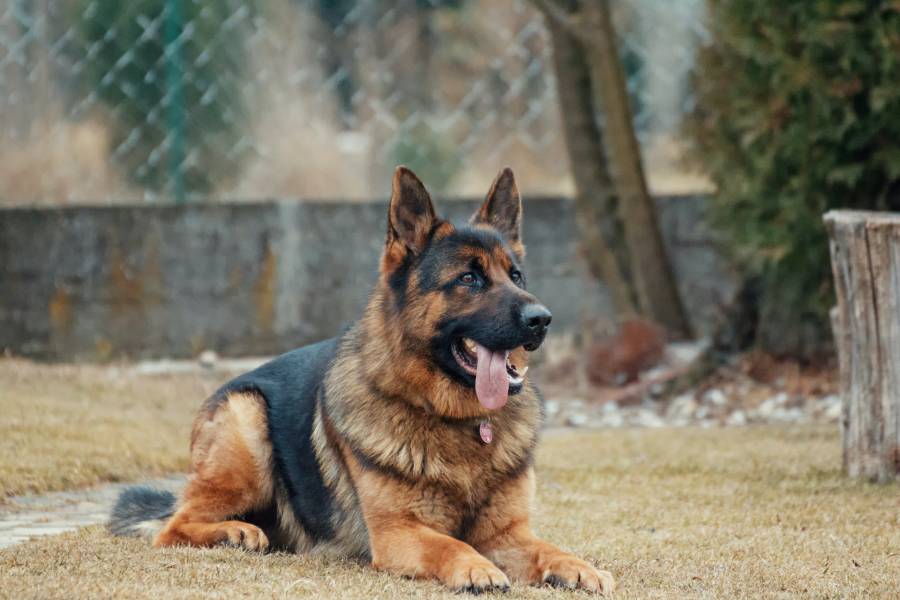Quick Navigation
Dogs’ pants and fast breaths can occur due to various reasons.
This could be playful activities, anxiety, stress, fever, overheating, or more.

While some of the reasons for a dog’s rapid breath are normal, others will require immediate medical attention.
Whichever the case, you need to know how to calm a dog’s breathing down.
Methods Of Calming A Dog’s Breathing Down
Fortunately, we have prepared this guide to take you through the essential tips to calm a dog’s breathing down.
Some of these methods are simple and can be quickly conducted independently, while others require a veterinary doctor’s guidance.
All in all, it is crucial that you know them to prepare you when the time comes.
1. Remove What Triggers The Fast Breath
Most people forget this method, but it is the first step to calming a dog’s breathing down.
You need to identify why your dog is breathing fast and keep your dog away from it.
For instance, your dog may be having an anxiety attack due to the presence of other animals or many people.
Keep your dog from such stressors, and you will see that its breathing pattern will begin to reduce.
To avoid this from recurring, let your dog play at home or in its playpen more often.
In addition, take your dog for a walk whenever there are fewer people outside.
Also, avoid parks until your dog becomes familiar with the environment and is comfortable being around many people.
2. Visit A Veterinary Doctor
Another way to calm a dog’s breathing down is to take it to a veterinary doctor.
It is as if it hasn’t been active, and there are no stress triggers around.
In addition, you want to make sure that your dog is healthy and that there is no underlying condition contributing to its rapid breaths.
After a checkup, your vet will identify the problem and hence manage it quickly before it becomes fatal.
3. Keep Off Hot Environments
Unlike us, dogs do not sweat.
Therefore, even though panting is one way to regulate dogs’ body temperature, keeping them away from humid and hot environments is always advisable.
Not only is this a way to calm a dog’s breathing down, but it also helps in preventing breathing problems that could strain your dog.
In this regard, ensure your home is cool for your dog, even if it means investing in air conditioners.
Make it a habit to open windows and doors frequently to allow fresh air into your house.
Additionally, do not overdress your dog.
4. Try Dog Pheromones
There are different forms of pheromones in the market today to calm a dog’s breathing down.
These include sprays, collars, wet wipes, or plug-in diffusers, and the best thing about them is that they are natural products.
You simply need to apply them on clothing and attach them to your dog to calm it down.
Note that dog pheromones are for short-term use.
For instance, if your dog is scared of car rides, you can use pheromones to manage the anxiety during the drive.
5. Deep Breaths
Practice deep breaths to calm a dog’s breathing down, especially if it plays or participates in any physical activity.
You can do so by taking a slow deep breath and letting your dog copy.
Once done, praise and reward it with a treat and continue with the activity until your dog’s breathing calms down.
Most importantly, keep eye contact with your dog and ensure you are in a quiet place.
6. Distract Dog With Toys
When your dog is distracted from fast breath stressors, the chances are that its breath will calm down.
Therefore, find a dog toy that your dog is not used to playing with and use as a distraction.
Make sure that the toy is brightly colored to quickly grab its attention.
Then, stand or sit in front of the dog and move the toy slowly in different directions.

Gradually, you will see that your dog’s breath will start reducing.
If it’s an underlying medical condition causing the fast breathing.
In this case, you can practice this technique to calm a dog’s breathing down before taking it to a veterinary doctor.
7. Play With Your Dog
If your dog is scared or anxious about something, you can easily distract its mind by playing with it and rewarding it with treats.
For instance, hide the treats around the house and let your dog find them.
If your dog is highly agitated, try to motivate it by pointing out where the hidden treats are.
Within a few minutes, your dog will be distracted and become cheerful again, thereby reducing its breath pattern.
However, try to avoid exposing your dog to what triggered its anxiety in the first place.
8. Rub Your Dog
This is a common technique to calm a dog’s breathing down, especially from physical exercises.
First, you must identify the areas where your dog feels comfortable when touched and apply long gentle strokes.
It could be the shoulder, chest, and base of its tail for as long as you approach it in a friendly manner.
9. Reduce Exercise
Fast breaths after long exercises are normal and will reduce within minutes.
However, if you are concerned about your dog, you should limit its activity level.
If they must exercise, keep an eye on them and make sure they move slowly.
It is especially if your dog is old or has ongoing respiratory issues that make it strain even more with extra activities.
10. Conduct First Aid
Your dog may have fast breathing patterns due to an underlying issue.
For instance, you may notice your dog breathing heavily and requires immediate medical attention.
However, how do you calm a dog’s breathing down before getting to the vet?
Well, in this emergency case, you should ask your dog for oxygen or administer nose drops to open the nostrils.
By doing so, you will have enough time to quickly get to your vet and have your dog treated.
That being said, make sure you have a dog emergency kit at home since you never know when you might need it.
Also, do not forget nasal drops if your dog has a dry or clogged nose, (two drops in each nare), and rush to your vet immediately if you feel there is a severe problem.
In addition, purchase oxygen tanks and masks to use to calm a dog’s breathing down in case of an emergency.
Although it is uncommon for dogs to get home oxygen therapy, if your dog is seriously ill, your veterinarian may discuss it with you.
How To Identify Abnormal Breathing In Dogs?
Dogs’ breath can be normal or can indicate an underlying issue.
For some breeds with short snouts, such as Bulldogs, Pugs, Pekingese, or French Bulldogs, the opening in their nose is too narrow.
The likelihood of a dog having breathing issues increases, on average, with the flatness of the face.
Unless they are panting, in which case their breathing rate will be higher, dogs typically breathe between 20 and 40 times per minute.
Large dogs breathe more slowly than smaller dogs, who often breathe a little bit more quickly.
They should be able to breathe easily, quietly, and with little effort.
To help you spot any new abnormalities, pay close attention to your dog’s breathing patterns both at rest and while active.
To quickly calm a dog’s breathing down, start by identifying the triggers.
However, how do you know whether your dog is in distress?
Well, there are common signs to look out for and take immediate action.
- Take a look at the dog’s belly or chest wall movement. If there are fast breathing patterns, you may want to look further into the situation. Also, your dog will be breathing with its mouth or nostrils open more than usual. The breaths can also be noisy.
- You may also notice your dog’s neck or head held out in front of its body.
- Gasping
Conclusion
Fast breaths in dogs do not necessarily mean that your dog has an underlying issue.
In fact, panting is healthy as they help in regulating a dog’s body temperature.
Simply put, dogs do not sweat, and by panting, water from their bodies evaporates.
Therefore, if you see your dog breathing fast after an exercise, this is normal, and it will probably calm down on its own within minutes.
However, if your dog is more agitated or the breaths last longer, it could be a sign of an underlying issue.
So, use the above methods to calm a dog’s breathing down before seeking medical attention.

Lucy is a real-time contributor to Purrfect n’ Pawesome, along with being a freelance writer to various pet forums and platforms. She started writing professionally in the year 2016. Earlier, she enjoyed her community life as a pet rescue volunteer and offered boarding services to pet owners. Her extensive experience in the pet field is now the basis for her writing at this site.
She loves to collect animal facts from around the globe and then transform them into amazing stories for her readers. For Lucy, the mission is to bring pet love to every home and equip the pet parents with the required useful and authentic information to nurture their pet accordingly.
She lives with her two cats and a shepherd mix, whom she loves the most. Despite her extremely busy life, she spends some time with wildlife and outer space to relax her mind and enhance her observation.
Purrfect n’ Pawesome is a platform that believes in providing our pets with the right kind of nurturing, care and upbringing to assist them in leading a healthy life. Go to our blog section and read out some pawesome and informative articles to ease your parenthood.



